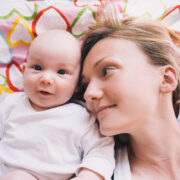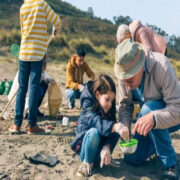Επικίνδυνες ουσίες στα καλλυντικά μωρών και ενηλίκων- Δείτε ποιά είναι και πετάξτε τα!
Τον Σεπτέμβριο του 2008, η «Επιτροπή για την Aειφόρο Aνάπτυξη για την Υγεία» (C2DS) απηύθυνε έκκληση στα…
Τον Σεπτέμβριο του 2008, η «Επιτροπή για την Aειφόρο Aνάπτυξη για την Υγεία» (C2DS) απηύθυνε έκκληση στα μαιευτήρια της Γαλλίας να σταματήσουν τη διανομή δωρεάν καλλυντικών προϊόντων για μωρά στις νέες μητέρες, προϊόντα τα οποία αποτελούν επικίνδυνο κοκτέιλ τοξικών ενώσεων.

Η C2DS είναι μια ανεξάρτητη ένωση που διευθύνεται από επαγγελματίες του τομέα της υγείας και σκοπός της είναι να δημιουργήσει τις μεθόδους και τα εργαλεία που θα συνοδεύουν τον νοσοκομειακό τομέα στην εφαρμογή της βιώσιμης ανάπτυξης. Στην δήλωσή της αναφέρεται στην τοξικότητα των καλλυντικών προϊόντων για παιδιά με ένα μακρύ κατάλογο επικίνδυνων ουσιών και αρνείται να διανέμει τα δώρα γέννησης εντός του θεσμικού τους οργάνου. Οι επιστήμονες, ο τοξικολόγος Andre Cicolella, ο παιδίατρος και ενδοκρινολόγος Charles Sultan με επικεφαλής τον καθηγητή Dominique Belpomme (ογκολόγο στο Νοσοκομείο Georges Pompidou και πρόεδρος της ARTAC –Ενωση για την Ερευνα Αντικαρκινικών Θεραπειών κατέληξαν σε συμπεράσματα που θα ανησυχήσουν τις μητέρες που καθημερινά χρησιμοποιούν υγρά μαντηλάκια, αφρόλουτρα και σαμπουάν για να καθαρίσουν τα μωρά τους.

Χημικό κοκτέιλ
Ακόμη και σήμερα, τα καλλυντικά για μωρά ή παιδιά δεν διαφέρουν από αυτά για τους ενήλικες παρά μόνο στην συσκευασία. Κρέμες και λοσιόν για το σώμα ή το πρόσωπο, αφρόλουτρα, κρέμες για την αλλαγή πάνας, υγρά μαντηλάκια … όλα υπόσχονται την «προστασία του δέρματος του βρέφους», «κλινικά δοκιμασμένα», «δερματολογιά ελεγμένα», «εγκεκριμένα από γιατρούς» ακόμα και «υποαλλεργικά» χαρακτηριστικά που δεν συμβαδίζουν με την σύνθεση τους. Για να διαβάσετε τον κατάλογο των συστατικών που χρησιμοποιούνται ίσως χρειάζεται πτυχίο χημείας για να αποκωδικοποιήσετε ουσίες όπως phenoxyethanol, mιthylparaben, propylparaben, butylparaben, isobutylparaben, EDTA.
Οι περισσότερες από τις τοξικές ουσίες που χρησιμοποιούνται είναι ενδοκρινικοί διαταράκτες όπως αποκαλούνται από τους επιστήμονες καθώς επηρεάζουν το σύστημα των ορμονών και μπορούν να δημιουργήσουν προβλήματα γονιμότητας, γενετικές ανωμαλίες, νευρολογικές διαταραχές και καρκίνο. Παρόλο που οι διάφορες αυτές ουσίες έχουν δοκιμαστεί, και οι συγκεντρώσεις που χρησιμοποιούνται είναι πολύ μικρές, οι ερευνητές φοβούνται για τις συνδυασμένες επιδράσεις όλων αυτών των χημικών ουσιών. Στην περίπτωση των καλλυντικών, δεν είναι ότι η δόση κάνει το δηλητήριο, αλλά η επαναλαμβανόμενη και μεγάλης διάρκειας έκθεση.

Στο βαθμό που η επιδερμίδα ενός μωρού είναι ιδιαίτερα ευαίσθητη σε χημικές ουσίες, ο κίνδυνος μόλυνσης από το δέρμα κατέχει υψηλή θέση μεταξύ αυτού του πληθυσμού.
χημικά προς αποφυγη σε σαμπουάν ,κρέμες, λοσιόν
-Propylene glycol
-Polyethylene glycol (PEG)
-Ethenolamines (DEA, MEA, TEA)
-Alcohol
-Fragrance
-Parabens (methyl-, propyl-, ethyl-)
Shampoos and Lotions for Kids (and Adults)
The skin absorbs chemicals very efficiently. Skin patches are an excellent way to administer drugs because they will then bypass the digestive system, avoiding unwanted side effects. The skin absorbs many substances more reliably than the digestive tract. Be careful what you put on your child’s skin. Read labels on shampoo and skin care products and you will discover a new world of exotic chemicals. The products that touch your baby’s skin include wipes, diaper rash creams, shampoo, soap, and moisturizers. Powders are never appropriate for babies. Talc is composed of sharp fine particles that can irritate a baby’s airways. Even cornstarch can be an irritant to airways when inhaled. Avoid using powder on your baby. Choose baby wipes that do not contain alcohol. Seventh Generation Baby Wipes and Tushies Wipes contain only natural ingredients without alcohol.
Shampoo Of all the baby care products shampoos tend to have the most ingredients. Use a shampoo that has natural herbal ingredients, preferably organic. Products by Aubrey Organics, California Baby, Dr. Brommer, and others are safer than commercial shampoos.
Two of the most problematic ingredients in shampoo are sodium lauryl sulfate (SLS) and propylene glycol. SLS is a wetting and foaming agent frequently used in shampoos and toothpastes. It can cause skin irritation, mucus membrane irritation and urinary tract infections, drying of the skin, and it is a mutagen capable of causing changes in genetic material in cells. Propylene glycol is a wetting agent or solvent. It is a common component of anti-freeze and brake fluid. It has been linked with kidney damage and liver abnormalities as well as rashes and dry skin.
Other common ingredients are not much better. Polyethylene glycol (PEG) is a degreaser used in spray-on oven cleaners. PEG dries the skin and has been identified as a potential carcinogen. DEA, MEA, and TEA, the ethanolamines, are hormone disrupting chemicals known to form cancer-causing nitrates and nitrosamines. These foaming agents have been associated with liver and kidney cancer. The synthetic paraben preservatives methyl-, ethyl- and propylparaben are also hormone disrupters with toxic properties. Some preservatives added to skin and hair products release formaldehyde (Urea and DMDM hydantoin). The word “fragrance” denotes synthetic compounds with up to 4,000 separate ingredients, many of which are carcinogenic, toxic, and capable of producing a wide range of symptoms including hyperactivity, irritability, headaches, and skin irritation.
Chemicals to avoid in shampoo and lotions
Propylene glycol
Polyethylene glycol (PEG)
Ethenolamines (DEA, MEA, TEA)
Alcohol
Fragrance
Parabens (methyl-, propyl-, ethyl-)
Lotions and creams
Some excellent products exist for moisturizing and protecting your baby’s skin. Products with essential oils can be especially soothing. It is probably best to avoid lavender, since it has been implicated as an estrogenic substance. Avoid lotions, ointments, and creams that contain petroleum or petrolatum and alcohol. Many of the same harmful chemicals found in shampoos will also show up in lotions. Companies that make an effort to use only natural ingredients include Weleda, Mustela, and California Baby, as well as the organic products by Aubrey, Avalon, and Jason. Several of these companies make diaper creams and baby lotions that are soothing and nontoxic. Natural moisturizers such as premium shea butter (www.sheainstitute.com) and virgin coconut oil work very well and have no added frangrances or chemicals. Shea butter contains vitamin A and the fatty acids in virgin coconut oil discourage free-radical production and bacterial growth in the skin.
http://www.healthy.net/scr/column.aspx?ColumnId=37&Id=896
http://goneis-paidia.com













Στέρηση ύπνου: Ναι, οι γονείς πρέπει να στέλνουν το έφηβο παιδί τους για ύπνο